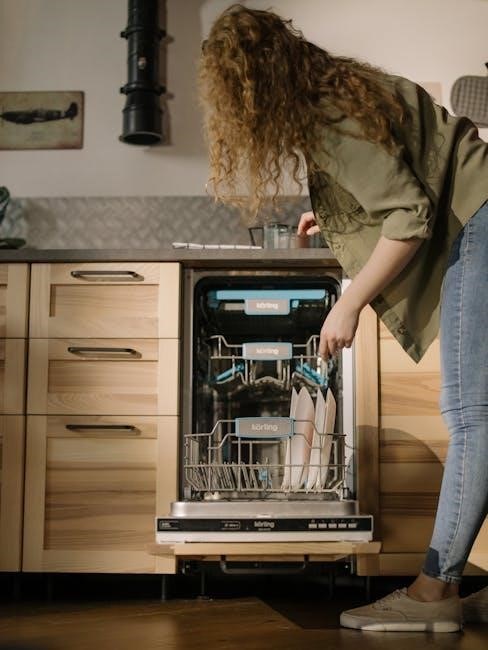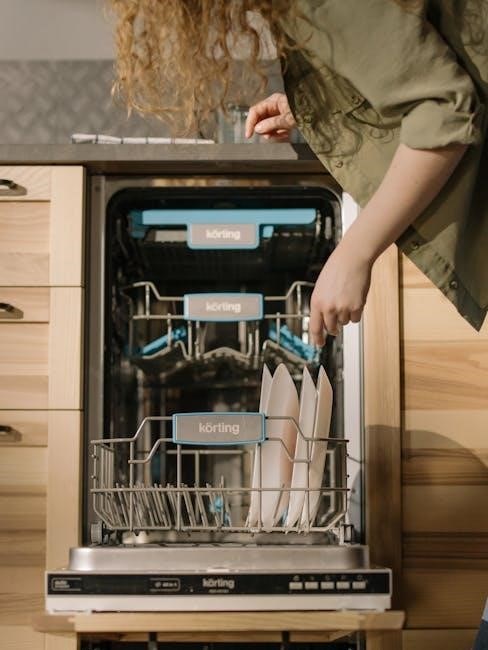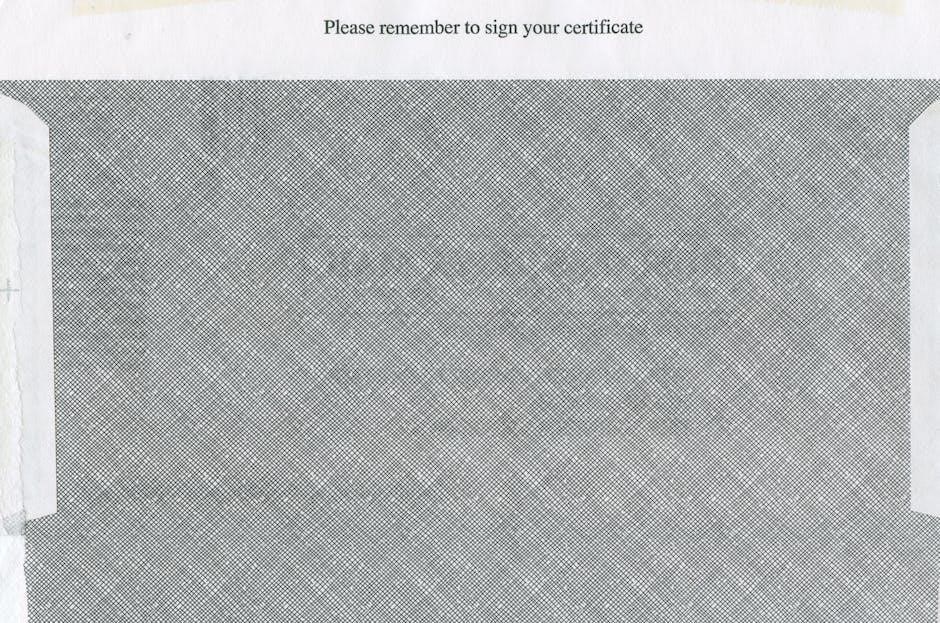Welcome to the Kenmore Elite Front Load Washer Manual! This guide helps you install‚ operate‚ and maintain your washer efficiently. It provides essential information for optimal performance and care‚ ensuring your appliance runs smoothly for years to come.
Overview of the Kenmore Elite Front Load Washer
The Kenmore Elite Front Load Washer is a high-performance appliance designed for efficient and effective laundry cleaning. With a large capacity drum‚ it accommodates bigger loads‚ saving time and energy. The washer features multiple wash cycles‚ including specialized options for different fabric types‚ ensuring optimal cleaning. Its advanced design promotes quiet operation and minimal vibration‚ making it ideal for home use. The Accela Wash feature allows for faster washing without compromising on cleanliness. Built with a durable stainless steel drum‚ it ensures long-lasting performance. Optional pedestals are available for height adjustment‚ enhancing convenience. Additionally‚ the CLEAN WASHER cycle helps maintain hygiene by removing buildup. This washer combines innovation and reliability for superior laundry care.
Importance of Reading the Manual
Reading the Kenmore Elite Front Load Washer manual is essential for proper installation‚ operation‚ and maintenance. It provides detailed instructions to ensure optimal performance and longevity of the appliance. The manual helps users understand safety precautions‚ energy-saving features‚ and troubleshooting tips. By following the guidelines‚ you can avoid common issues and ensure efficient cleaning. It also explains how to use advanced features like the Accela Wash cycle and the CLEAN WASHER function. Proper usage reduces the risk of damage and extends the washer’s lifespan. Additionally‚ the manual includes diagnostic tools for error codes and maintenance routines to prevent mold and odor buildup. It is a comprehensive resource for getting the most out of your Kenmore Elite Front Load Washer while minimizing repair needs and ensuring safety.
Key Features of the Kenmore Elite Front Load Washer
The Kenmore Elite Front Load Washer offers advanced features designed for efficient and superior cleaning. Its large capacity drum accommodates bigger loads‚ saving time and energy. The Accela Wash feature provides quick cycles for faster washing without compromising cleanliness. The washer also includes a CLEAN WASHER cycle‚ specifically designed to remove odor and mold buildup using bleach or specialized cleaners. Additional features like multiple wash cycles and temperature controls allow for customized cleaning options. The front-loading design ensures gentle handling of fabrics while providing effective stain removal. These features combine to make the Kenmore Elite Front Load Washer a reliable and versatile choice for modern laundry needs‚ ensuring a thorough and efficient cleaning experience; The washer’s energy efficiency also helps reduce utility costs over time‚ making it a practical investment for homeowners. Furthermore‚ its sleek design and quiet operation enhance user convenience. By incorporating innovative technology‚ the Kenmore Elite Front Load Washer delivers exceptional performance and durability‚ meeting the demands of busy households.

Installation Instructions
Ensure proper installation by preparing the site‚ leveling the washer‚ connecting water and power supplies‚ and securing the drain hose. Follow the manual for safety and efficiency.
Pre-Installation Requirements
Before installing the Kenmore Elite Front Load Washer‚ ensure the site is level‚ has proper drainage‚ and is near water and power supplies. Verify the floor can support the washer’s weight. Measure the space to ensure the washer fits comfortably. Check for any obstructions and ensure the area is clear. If moving the washer‚ handle it carefully to avoid damage. Gather necessary tools like a wrench and pliers for connections. Ensure the water supply lines are compatible and in good condition. If installing on a pedestal‚ follow the manufacturer’s guidelines for stability. Proper preparation ensures a safe and efficient installation process.
Step-by-Step Installation Guide
Start by carefully unpacking the Kenmore Elite Front Load Washer‚ ensuring all parts are included and undamaged; Place the washer on a level‚ sturdy floor to prevent vibration. Use the adjustable legs to stabilize the appliance. Position the washer near the water supply lines and drainage system. Attach the drain hose to the washer and secure it to the laundry sink or standpipe. Connect the hot and cold water supply lines to the corresponding ports on the washer. Tighten all connections firmly to avoid leaks. Plug the power cord into a grounded electrical outlet. Double-check all connections for security and proper alignment. Ensure the area around the washer is clear for proper ventilation and access.

Connecting Water and Power Supplies
Connect the Kenmore Elite Front Load Washer to water and power supplies carefully. Attach the hot and cold water hoses to the corresponding inlet ports on the washer. Ensure the hoses are securely tightened to prevent leaks. Connect the other ends of the hoses to the household water supply. For the drain‚ secure the drain hose to a laundry sink or standpipe‚ ensuring it doesn’t kink or clog. Plug the washer into a grounded electrical outlet‚ avoiding extension cords. Verify all connections are tight and properly aligned. Double-check for leaks around water connections before first use. Proper connections ensure safe and efficient operation of your washer.

Operating the Kenmore Elite Front Load Washer
Start by understanding the control panel and selecting the appropriate wash cycle for your load. Properly load laundry‚ ensuring balanced distribution for optimal cleaning and machine performance.

Understanding the Control Panel
The control panel on the Kenmore Elite Front Load Washer is designed for intuitive operation. It features a digital display and buttons for selecting cycles‚ temperature‚ and options. Key buttons include Power‚ Start/Stop‚ and Cycle Select. Use the Temperature button to choose hot‚ warm‚ or cold water. The Soil Level button adjusts wash intensity based on load dirtiness. Additional options like Steam Clean and Sanitize can be enabled for deeper cleaning. The digital display shows cycle progress‚ remaining time‚ and error codes if issues arise. Familiarize yourself with these controls to customize wash cycles and optimize cleaning results. Proper use ensures efficient and effective laundry care.
Selecting the Right Wash Cycle

Selecting the right wash cycle on your Kenmore Elite Front Load Washer ensures optimal cleaning for various fabric types and soil levels. The washer offers multiple pre-set cycles‚ including Normal‚ Heavy Duty‚ Delicate‚ and Bulky. Use the Normal cycle for everyday laundry‚ while Heavy Duty is ideal for heavily soiled items. The Delicate cycle gently cleans fragile fabrics‚ and Bulky handles larger items like comforters. Additional options include Steam Clean for deep stains and Sanitize to eliminate bacteria. Always match the cycle to the fabric type and soil level for best results. Refer to the manual for specific cycle recommendations to ensure your laundry is cleaned effectively and fabrics are protected.
Loading Laundry: Best Practices
Properly loading your Kenmore Elite Front Load Washer ensures efficient cleaning and protects your fabrics. Always check fabric care labels for specific instructions. Separate delicate‚ heavy‚ and colorful items to prevent damage or discoloration. Avoid overloading the washer‚ as this can reduce cleaning effectiveness and potentially damage the machine. Balance the load to ensure even distribution‚ especially for bulky items like blankets or towels. Place smaller items like socks and lingerie in mesh bags to prevent loss or damage. For optimal performance‚ leave enough space for clothes to move freely during the cycle. Use the recommended detergent dosage to avoid residue buildup. Regularly cleaning the washer with the CLEAN WASHER cycle helps maintain performance and freshness.
Troubleshooting Common Issues
Identify issues like spin failures or error codes. Refer to the manual for specific solutions. Resetting the washer or checking connections often resolves problems quickly.
Diagnosing Spin and Agitate Function Problems
Diagnosing spin and agitate function problems in your Kenmore Elite Front Load Washer starts with identifying symptoms. If the washer isn’t spinning or agitating‚ check for error codes on the control panel‚ which can indicate specific issues. Ensure the washer is properly installed and balanced‚ as imbalance can prevent proper spinning. Regular cleaning‚ such as running a CLEAN WASHER cycle with bleach‚ helps maintain functionality and prevents mold buildup. If problems persist‚ inspect the water supply connections and drain pump for blockages. For advanced issues‚ refer to the manual for guidance on replacing parts like the water level sensor or motor control board. Always consult the manual for specific error code meanings and repair instructions.
Resolving Error Codes
Resolving error codes on your Kenmore Elite Front Load Washer involves identifying the specific issue indicated by the code. Common error codes like E1 or E2 often relate to water level or drainage problems. Check the manual for a detailed list of error codes and their meanings. Start by restarting the washer to clear temporary glitches. If the issue persists‚ ensure the water supply hoses are not kinked and the drain pump is clear of debris. For complex errors‚ such as motor or sensor malfunctions‚ refer to the manual for diagnostic steps or contact Sears Parts Direct for assistance. Regular maintenance‚ like running a CLEAN WASHER cycle‚ can prevent many issues. Always use the correct detergent and follow load guidelines to avoid triggering error codes. If unsure‚ consult the manual or a professional for further guidance.
Addressing Odor and Mold Buildup

Odor and mold buildup in your Kenmore Elite Front Load Washer can be addressed by running the CLEAN WASHER cycle with bleach or a cleaner designed for front-load washers. Regularly leave the washer door open after use to dry the interior. Check and clean the gasket and drain pump filter to remove debris. If odors persist‚ ensure proper ventilation and avoid using too much detergent‚ as residue can contribute to mold growth. Refer to your manual for specific cleaning instructions tailored to your model. Maintaining a clean washer ensures fresh laundry and prevents unpleasant odors from developing over time. Consistent upkeep is key to longevity and performance.

Maintenance and Care

Regular maintenance ensures optimal performance. Run the CLEAN WASHER cycle with bleach‚ clean the gasket‚ and check the drain pump filter. Refer to Sears Parts Direct for parts and guides to keep your Kenmore Elite washer in top condition; Proper care extends its lifespan and maintains efficiency.
Cleaning the Washer
Cleaning your Kenmore Elite Front Load Washer is essential for maintaining hygiene and performance. The washer features a dedicated CLEAN WASHER cycle designed to remove odor and mold buildup. For this cycle‚ add 1 cup of chlorine bleach or a washer cleaner to the empty drum. Run the cycle to sanitize the interior. Additionally‚ wipe down the gasket and detergent dispenser after each use to prevent residue accumulation. Regularly check and clean the drain pump filter to ensure proper water flow. Leaving the lid open after a cycle allows the interior to dry‚ preventing mold growth. Follow these steps to keep your washer fresh and functioning optimally.
Regular Maintenance Tips
Regular maintenance ensures your Kenmore Elite Front Load Washer performs efficiently and lasts longer. Run the CLEAN WASHER cycle monthly using bleach or a washer cleaner to eliminate odors and mold. Check and clean the drain pump filter regularly to prevent clogs and ensure proper water flow. After each use‚ leave the lid open to allow the interior to dry‚ reducing mold growth. Inspect the drain hose for kinks or blockages and ensure it’s properly vented. Clean the gasket and detergent dispenser periodically to remove residue; For persistent odors‚ repeat the cleaning cycle or use a specialized washer cleaner. Regular upkeep keeps your washer fresh and functioning at its best.
Replacing Parts: A Guide
Replacing parts on your Kenmore Elite Front Load Washer can be done with the right tools and guidance. Always refer to your model-specific manual or Sears Parts Direct for accurate diagrams and instructions. Start by diagnosing the issue using error codes or troubleshooting guides. Once identified‚ order genuine Kenmore parts to ensure compatibility. Before replacing any component‚ disconnect power and water supplies for safety. For complex parts like the control board or drain pump‚ follow step-by-step instructions in the manual. Regularly replacing worn-out seals or gaskets can prevent leaks and mold buildup. Keep track of maintenance and repairs to extend the lifespan of your washer. Proper part replacement ensures optimal performance and prevents further damage.


































































